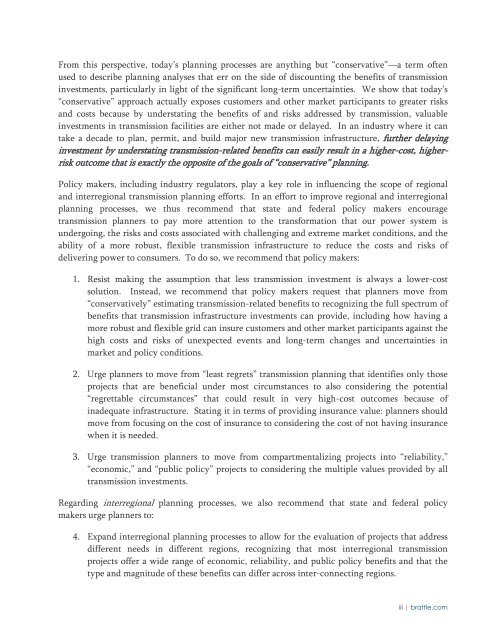THE BRATTLE GROUP
pvrbYG
pvrbYG
Create successful ePaper yourself
Turn your PDF publications into a flip-book with our unique Google optimized e-Paper software.
From this perspective, today’s planning processes are anything but “conservative”—a term often<br />
used to describe planning analyses that err on the side of discounting the benefits of transmission<br />
investments, particularly in light of the significant long-term uncertainties. We show that today’s<br />
“conservative” approach actually exposes customers and other market participants to greater risks<br />
and costs because by understating the benefits of and risks addressed by transmission, valuable<br />
investments in transmission facilities are either not made or delayed. In an industry where it can<br />
take a decade to plan, permit, and build major new transmission infrastructure, further delaying<br />
investment by understating transmission-related benefits can easily result in a higher-cost, higherrisk<br />
outcome that is exactly the opposite of the goals of “conservative” planning.<br />
Policy makers, including industry regulators, play a key role in influencing the scope of regional<br />
and interregional transmission planning efforts. In an effort to improve regional and interregional<br />
planning processes, we thus recommend that state and federal policy makers encourage<br />
transmission planners to pay more attention to the transformation that our power system is<br />
undergoing, the risks and costs associated with challenging and extreme market conditions, and the<br />
ability of a more robust, flexible transmission infrastructure to reduce the costs and risks of<br />
delivering power to consumers. To do so, we recommend that policy makers:<br />
1. Resist making the assumption that less transmission investment is always a lower-cost<br />
solution. Instead, we recommend that policy makers request that planners move from<br />
“conservatively” estimating transmission-related benefits to recognizing the full spectrum of<br />
benefits that transmission infrastructure investments can provide, including how having a<br />
more robust and flexible grid can insure customers and other market participants against the<br />
high costs and risks of unexpected events and long-term changes and uncertainties in<br />
market and policy conditions.<br />
2. Urge planners to move from “least regrets” transmission planning that identifies only those<br />
projects that are beneficial under most circumstances to also considering the potential<br />
“regrettable circumstances” that could result in very high-cost outcomes because of<br />
inadequate infrastructure. Stating it in terms of providing insurance value: planners should<br />
move from focusing on the cost of insurance to considering the cost of not having insurance<br />
when it is needed.<br />
3. Urge transmission planners to move from compartmentalizing projects into “reliability,”<br />
“economic,” and “public policy” projects to considering the multiple values provided by all<br />
transmission investments.<br />
Regarding interregional planning processes, we also recommend that state and federal policy<br />
makers urge planners to:<br />
4. Expand interregional planning processes to allow for the evaluation of projects that address<br />
different needs in different regions, recognizing that most interregional transmission<br />
projects offer a wide range of economic, reliability, and public policy benefits and that the<br />
type and magnitude of these benefits can differ across inter-connecting regions.<br />
iii | brattle.com


